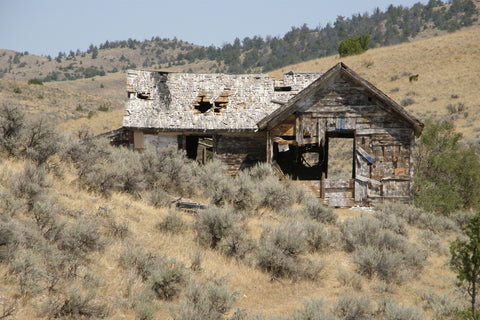
This Ore-Rich Montana Ghost Town Is Now Ground Central for Mountain Bikers
In the hills 6 miles north of Three Forks, in south-central Montana, the Emerson Mining District had all the potential of being highly productive, but it never quite got going. Ironically, as the adjacent valley contains the headwaters of the Missouri River, the main obstacle it faced was a dearth of water. In the mid-1860s, when placer mining for gold was in style, local rancher and sometime prospector Al Nichols found promising quartz samples in a dry stream bed in these hills. He hauled a sackful of the rocks 4 miles to the Jefferson River just so he could crush them and sift the scree in his pan. The net result was about $4 worth of ore. Given the effort it took, he abandoned the idea as worthless.
Sometime in the early 1870s partners John Emerson, James Aplin, Frank Akin and Samuel Seaman were prospecting the same hills and sank a shaft to a vein of copper quartz they named the Green Eagle mine. The find attracted a cluster of hopeful prospectors, who registered several mines. But as the owners awaited financing from “Eastern moneymen” that never materialized, their claims amounted to little more than holes in the ground. Meanwhile, Green Eagle’s owners came to the realization that to develop a copper mine miles from any railroad or town would require a vast amount of capital, which none of them possessed, and at the time copper was not a valuable commodity. So, they too abandoned their claim. Asher Paul and George Lea had been working a nearby silver mine, though it promised only a small income, given the low grade of ore they found. The devaluation of silver in 1883 killed that operation.
GET HISTORY'S GREATEST TALES—RIGHT IN YOUR INBOX
Subscribe to our HistoryNet Now! newsletter for the best of the past, delivered every Monday and Thursday.
Close
Thank you for subscribing!
Submit
In 1885 Jacob Hopping took a renewed interest in the Green Eagle and deepened the shaft to 65 feet before the ore petered out. Partnering with Green Eagle co-founder Seaman, he then sank a nearby shaft the pair named the Burlington. Reportedly offered $100,000 for their mines, the partners declined. Given the nationwide financial panic and bank failures in the headlines, they replied tongue in cheek that they preferred to invest their money in the ground. Shortly thereafter they hit a massive fault and lost the ore seam again.
Also in the district, Josh Parker and Al Shedd operated a mine called the Crystal Canon, while Perry Parks and a partner recorded only as Campbell mined low-grade iron ore for a time. They shipped it as flux to a smelter recently built in nearby Toston to handle gold from the Radersburg Mining District. Other less-productive mines frequently changed ownership, either by sale or through relocation (i.e., jumping).
All this mining activity at the tail end of the 19th century gave rise to a settlement residents named Copper City, though the hamlet never amounted to more than a few homes, and there’s no record of a post office. Call it the ghost town that never was.
Only
a few structures remain of the namesake ghost town.
Finally, in 1905 investors made inquiries toward establishing a paying mine in the district. A year later Herbert G. Dunbar, a prosperous sheep rancher from Logan, and other wealthy partners from the Twin Forks/Bozeman region organized the Three Forks Mining Co. and consolidated a half dozen claims they renamed the Copper Star. “[The company] own six claims in one of the greatest undeveloped copper districts in the world,” the Three Forks Herald reported optimistically, “this being the opinion of several copper experts.” Sure enough, the ledge of ore running through the Copper Star was soon providing 2 to 60 ounces of copper per ton, with trace silver and gold. But then came the financial Panic of 1907, when investment money dried up, and work on the company shafts ground to a halt.
By 1916 Dunbar had a new partner, Jacob Hopping’s son, Carl, and the two of them reopened the Copper Star adits. That April 24 The Butte Miner interviewed Dunbar. “Well, we’ve got it at last,” the mine owner enthused. “We have cut into a vein about 4 feet in width and very high in its percentage of mineral. The assays run between 30 and 40 percent [copper]. We got this below the 350-foot level. Our hoist is good for a depth of 500 feet.” By June the partners had deepened the shaft from 300 to 400 feet, retimbered the original section of the shaft and replaced the old gallows frame with a modern hoist capable of extending to 1,000 feet.
Residents had hoped the sprawling Anaconda Copper Mining operation in Butte
would reopen Copper City’s claims, but no such luck.
At the outset of World War I the demand for copper had surged to astronomical heights, thus the partners seemed set. But the war and their prospects wouldn’t last. By 1920 the price of copper had plummeted. The downturn made only a small dent in copper production among the Butte mines, but it was enough to close the Copper Star. Around this time an English company took an interest in the district’s iron ore mine, purchased it and then sold it to the massive Anaconda Copper Mining Co., sparking a rumor Anaconda would reopen the district and build a large smelter in Three Forks. Nothing came of it.
Mountain bikers explore the Copper City singletrack
trail, on Bureau of Land Management property north of Three Forks.
All that remains of Copper City today is the concrete pad of the Three Forks Mining Co. building, rusty mining equipment and the dilapidated hulks of what a century ago must have been three substantial homes. Completed in 2019, the 22-mile Copper City singletrack mountain bike trail zigzags across hills potentially still laden with riches.
